Canon Speedlite 600EX-RT Flash Review
I guess when the competition is waving around 200mm zoom and fancy self-calibrating color filter system, and your premiere flash only zooms to 105mm and does nothing fancy at all, it’s time to up the game. Of course, this is Canon we’re talking about, and when they up the game, they really do up the game. The Speedlite 600Ex-RT, and the Speedlite 600Ex for countries that don’t license the 2.4GHz spectrum for public use, are Canon’s answer to the Nikon SB-900/910 and the first really big upgrade to not only their top end Speedlite system but their wireless flash system as well.
Just looking at the flash, the 600Ex-RT doesn’t look like just a bigger 580Ex II, there are a number of major and obvious changes aside from the size of it. Quite possibly the most noticeable change to the 600Ex-RT is the new rear display and control panel. Gone is the old small fixed segment LCD replaced with a larger (1-7/8” x 1-3/16”) matrix LCD, meaning the display can now display iconography and text anywhere on the panel. The control scheme has also been reworked, and I’ll be coming back to that in depth later on. The least obvious, aside from the RT in the name, but perhaps biggest advancement is the introduction of a new radio based remote flash system, and again I’ll be coming back to this in depth.
 |
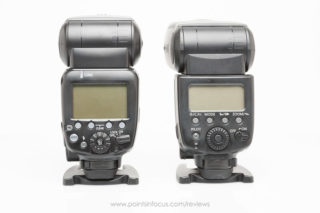 |
But first, I want to start with the business end, why I buy flashes, the flash head.
The overall power output of the 600EX strobes is very similar to that of the 580Ex II that proceeded it. However, that’s not unexpected. These small flashes make most of their “power” or reach by focusing light better with the zoom head and not by generating more light. There are real limits in just how much energy can be stored and dissipated in this size package.
Like it’s predecessor, the 600EX strobes features manual control from full to 1/128 power in 1/3 stop increments. And TTL control ±3 stops in 1/3rd stop increments. The actual controlled lower limit can be quite dim. The less than 1.8ms full power discharge time is fast enough to support the 1/250th x-synd speeds found on most Canon cameras, and the 1/300th x-sync on APS-H EOS 1 bodies. Beyond the 1/250th, High Speed Sync mode is necessary.
High Speed Sync is achieved by strobing the flash rapidly to match the movement of the shutter across the frame. As a result when shooting at HSS shutter speeds, the flash’s output power is significantly reduced. The following image shows sames of HSS powers compared to x-sync powers. Both sets of images were shot at close range at f/22 ISO 100–though using a wider aperture or faster ISO would extend the range and brightness.
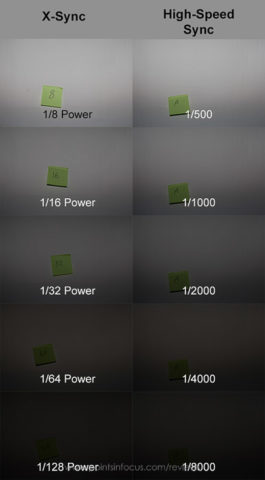
Canon has extended the zoom range, both on the wide and telephoto ends. On the long end, the zoom range has increased 90% from 105mm to 200mm. While it sounds like a big deal, it honestly doesn’t buy the 600Ex all that much more in terms of flash power, raising the guide number by only 2 meters at the 200mm position while all the other positions retain identical power levels to the 580Ex II.
If you’re hoping you can toss your better beamer or similar flash extender, and get the same effect from the flash itself, well that’s not going to happen. Where the longer zoom range helps, though only slightly is with controlling spill for creative effect. That said, even in that use case the 200mm coverage isn’t nearly as tight as you might suppose.
The new zoom head also zooms wider than the 24mm limit on the 580Ex II. The new lower limit provides a beam equal to the angle of view of a 20mm lens on a full frame camera (or a 12.5mm lens on a crop body). There’s still a jump in beam angle between the 20mm where the zoom head stops, and the 14mm of the flip-out wide-angle panel, but it’s at least a little smaller. The ideal situation, in my opinion, would be for Canon to get the zoom down to 16mm where their ultra-wide-angle zooms stop, and have the flip out panel for the 14mm ultra-wide-angle primes.
So how does the zoom head and power compare to the competition?
The Canon’s 600Ex-RT stacks up well against Nikon SB-910. The SB-910 offers a little better wide angle coverage, going down all the way to 17mm without needing to pop out the wide-angle panel. On the other hand, the Canon 600Ex-RT generally does a little better job putting out light. At comparable focal lengths, the differences in guide numbers can be up to 18% higher in favor of the 600Ex-RT. All told though, the two flashes are very evenly matched; neither system has any real decisive advantage in power or zoom.
The zoom head retains all the features of the 580Ex II in addition to the wide-angle panel and catch light card. It rotates 180° to the left and right, as tilt from -7° to +90°. The pan motion has click stops at 60°, 75°, 90°, 120°, 150°, and 180°. The tilt has click stops at -7°, 0°, 45°, 60°, 75°, and 90°. Also like the 580Ex II, the head locks when it’s pointed forward or fully up, requiring you to hold the bounce-lock release button to rotate the head out of those positions.
New to the zoom head are the external parts of the new gel mount and color detection system, most notably the three nibs on the top of the flash, and the sensor and emitter on the bottom. The idea, at least as I see it, in being able to detect the color of a gel is to provide the photographer with a shortcut to setting the white balance when shooting indoors with a flash. That is, the simple act of gelling the flash to tungsten tells the camera that the scene is tungsten. Of course, detection isn’t always desirable, and the auto color filter detection can be disabled though personal function 1.
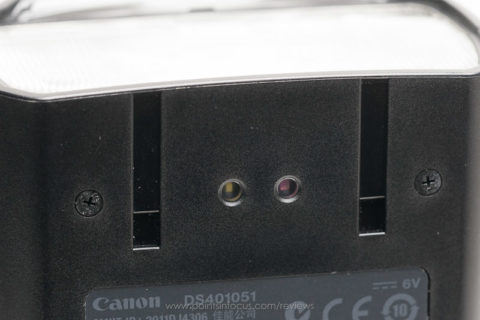
The novelty of the system, to me at least, is how Canon went about detecting the filters. Nikon put a similar in intent, gel detection system in their SB-900 and SB-910 flashes, but used a 4-bit coding pattern by applying opaque/reflective bits to the gel. Canon instead went for a direct measurement system. A small light pipe built into the bottom of the holder, which directs light from a small white LED that’s shined through the gel to a detector.
In theory, this system would allow the 600Ex to be able to detect and measure any color correction gel, be it Canon’s or any of the other commercial alternatives. Unfortunately, it doesn’t quite work that way. In practice, the system seems to be designed to deal with only the two Canon gels—a full CTO and a 1/2- or 1/4-CTO (I’m not entirely sure on the exact density of the “low” density filter). Commercial gels that are similar in color and density will likely be detected as well, though the results may vary since the flash seems to only understand the properties of the Canon parts.
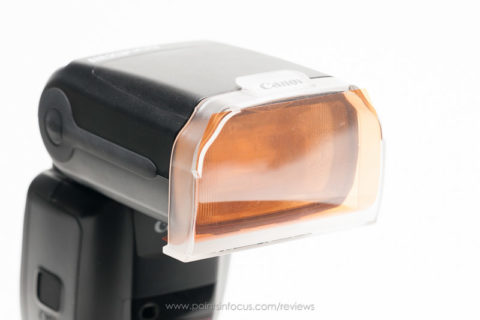
This is a rather disappointing situation to me, as I don’t see any readily obvious reason that the flash shouldn’t be able to measure the gel and apply the appropriate color temp corrections. Doubly so since it seems that the system doesn’t even work with green fluorescent conversion filters.
On the other hand, it’s not as though the lack of automatic color temp adjustments is a show stopping loss. The system, at best, is a “shortcut” to simply setting the camera’s white balance to tungsten or fluorescent. In any event, the color information system can be disabled and enabled by changing personal function 05.
At least as a consolation price, Canon’s gel holder will hold any 75 x 75mm square gel without requiring you to cut them in any fancy way.
The lower half of the flash is where all the power, control, and intelligence is. The front has been slightly reorganized from the 580ex II, namely the auto flash sensor has been moved up into the optical wireless receiver area to make way for the larger AF illuminator needed to cover the 61-point AF system introduced with the 5D mark III and EOS-1D X. The AF illuminator will fully cover all 61-points when used with a 28mm or longer lens, with an effective range of at most 32.8 feet (10m) for center points and 16.5 feet (5m) for the peripheral points.
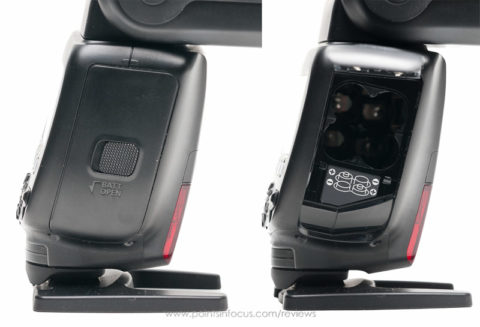
The power situation is typical for Canon’s high-end flashes, 4 AA batteries inserted from the right side of the flash. Batteries are arranged the same as they were in the 580Ex II; a square of 4, half + side out, half – side out. Also like the 580Ex II, the battery door is gasketed to keep dust and weather out.
When it comes to power, like other flashes, you get the best mileage out of NiMH rechargeables instead of alkalines—I use Eneloops. Both because you can reuse them, and because the higher current they can supply cuts recycle times slightly.
Real heavy flash users, however, will probably want consider going for the high voltage power pack options. High voltage power packs, like the Canon CP-E4 Compact Battery pack or a Quantum Instruments Turbo power pack, improves the already snappy recycle times by feeding the flash capacitor circuit with a 300 volt source backed by higher capacity sources (more AAs, sealed lead acid, or lithium ion batteries). That said, while there is over temperature protection, at high powers and with the fast recycle times provided by an external high voltage power pack, it is possible to damage the plastic lens on the flash head before the over temp protection can shut the flash down.
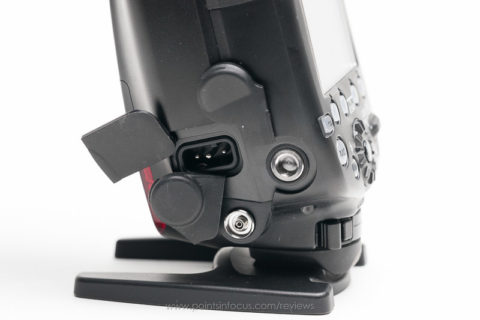
Rounding out the other miscellaneous connectors on the flash are the PC Sync port (measured at 4.5V by my multi meter), a threaded socket for mounting to Canon’s flash bracket, and a camera sync port (600Ex-RT only) for the remote camera triggering capabilities that are part of the new radio remote system.
With brings us to the most outwardly apparent change from the 580ex II to the 600Ex[-RT], the rear interface. The display is bigger, the buttons are different, and on a whole, the whole system is much better than what the 580Ex II had.
The new display is just under 1-1/4 x 2 inches, and is a full matrix LCD display. This dramatically improves the ability for the flash to convey information and settings. Like previous Speedlites the display is reflective, and side/backlit. Unlike previous Speedlites the backlight can be either green or orange in color, and can be set to reflect the mode the flash is in. By default, the backlight is green for single flash and wireless master, and orange for wireless slave operations. Personal functions 2 (single flash), 3 (wireless master), and 4 (wireless slave) control the colors in each of the respective modes.
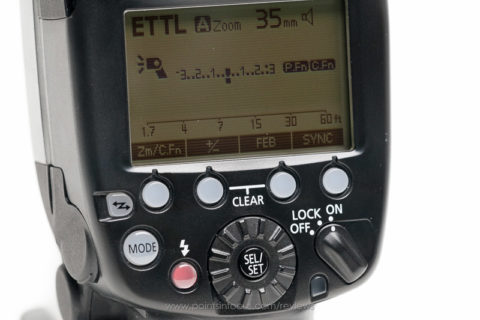
Personally, I have mine set to green for single flash and orange for the two remote modes, simply because I use the single flash mode most and so it’s useful to call attention to the flash when it’s in the wireless modes. That said, some more colors, say maybe white and red, wouldn’t hurt.
While the controls may look familiar to any 400 and 500 series Canon Speedlite user, they’re very different in many respects.
The power switch now mirrors the on/lock/off 3 position switches that Canon has used on so many cameras. In the new lock position, the controls are locked out so that flash settings cannot be accidentally changed.
The 4 function buttons under the LCD display are no longer fixed function, as they were on the 580Ex II; instead, the change function based on the flash mode and other various conditions. In this way, Canon has eliminated almost all of the holding buttons for 2 seconds to change settings, or repeatedly tapping your way through multiple options. In fact, only the custom function/personal function menu requires holding a button to access.
The flexible function buttons also means that the flash tends to keep the most useful functions in front of you depending on the mode.
For example, in multi-flash mode on a 580Ex II you had to repeatedly press the set button to cycle though the flash power, frequency, and number of flashes settings. On the 600Ex in multi-flash mode, the 4 function buttons become zoom, power, number of flashes, and frequency respectively from left to right.
In more complex modes, like wireless operation, there can be multiple “menus” that change the function of the 4 function buttons as you step through them. For example in wireless ETTL master mode, the first “menu” displayed sets zoom, flash exposure comp, and flash exposure bracketing; the second menu, master flash firing, ratio mode (all, A:B, and A:B C), and control over the individual ratios (Gr[oup]); in the 3rd menu, the channel, sync mode, and the ability to save and load the settings. The options further vary in wireless master manual, wireless master multi, and wireless slave modes.
Another new function tied into the multi-function buttons is clearing the flash settings. Holding the middle two function buttons, indicated by “clear” on the flash, will reset all flash functions except wireless channel, radio ID, custom and personal functions. The 2-button clear function can be used to quickly reset a flash from any given configuration to a sound default state (single flash mode, auto zoom, 0 flash exposure compensation, and flash exposure bracketing off).
Flash modes are still selected by using the mode button, which has been moved to its own position freeing up one of the function button spots. Available modes are E-TTL/TTL, Manual, Multi flash, External Auto flash, and external manual.
One of the big improvements to the 600Ex is the inclusion of a single purpose button to switch through the wireless modes; single flash, optical commander, optical slave, radio commander, and radio slave. The wireless button toggle sequence can be modified though personal function 06, giving users the ability to limit the wireless options to optical, radio, or both (default). The personal function allows users who haven’t fully adopted the RF system, or alternatively those who no longer use the optical one, to shorted the numbers of intermediate modes they have to step through when changing the wireless operation.
Finally, rounding out the controls, the pilot lamp works identically to the pilot lamp on the old 580Ex IIs. Pressing it test fires the flash. Green indicates that the flash is ready to shoot when quickflash mode is enabled. Finally, glowing red indicates that the flash is fully ready to shoot.
While the increased zoom range and power is somewhat underwhelming, the big new addition to the 600Ex-RT is the new radio wireless communication system, and it’s not just Canon’s old optical system over radios. Canon definitely aimed to address many of the reasons people turn to 3rd party radio triggers when they put together their system.
For starters, there’s the inhibited range that you get from going from an optical line of sight system to a radio system. Canon’s RF range isn’t tremendous at 100 feet (30m), it’s certainly better than the 50 feet (15m) of the optical system, and it will penetrate some walls and can’t be overwhelmed by the sun. However, it’s not PocketWizard class (1600 feet/500m). That said, given that one of the features that Canon has added to the system is remote camera triggering, the range is a bit wimpy.
Since I already mentioned it, I might as well talk about remote shooting. Remote cameras, or linked shooting as Canon calls it, is a feature of the radio system only, and is unavailable on the Speedlite 600Ex. The system allows up to 16 cameras to be triggered simultaneously using either 600Ex-RT Speedlites or ST-E3-RT Speedlite Transmitters on the remote cameras to activate them. Moreover, with 2012 and newer cameras such as the EOS-1D X and 5D mark III, the camera control is achieved via the hot shoe communication without the need for any extra cables. For older cameras, the SR-N3 release cable, is connected form the remote port on the flash, to N3 cable release port on the camera.
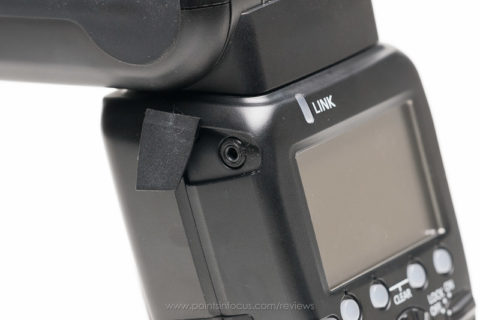
The ability to sync up to 16 other cameras certainly seems nice, but it’s no replacement for pocket wizards in many situations as the range simply isn’t there to support it. On the other hand, with 10,000 radio IDs, and 16 channels to work on, Canon’s system certainly has the potential to support similar numbers of photographers working in the same environment. Then again, the problem of range comes up, where an NBA regulation basketball court is pushing the limits of the range, never mind something like a remote camera in the ceiling of a typical arena.
But this isn’t just a remote camera system, first and foremost, it’s a wireless flash system, and there are changes here as well. The RF system starts with a basic implementation of the same 3 group flash system that the optical system uses, including the same A:B + C ratio + compensation system. When used on pre 2012 bodies, the RF system is limited to this mode and works as little more than a radio version of the existing optical system—though there is one big caveat, on pre 2012 bodies, in RF mode, the X-sync speed is 1-stop slower than it would be in optical mode.
With 2012 bodies and operating in RF mode, the real big advance is accessible, group flash mode. In group flash mode (Gr) can be used. Group flash mode enables the use of up to 5 groups of up 15 RF capable (currently only 600Ex-RT) flashes, and each group is individually controlled in either manual power levels or TTL exposure compensation.
In other words, it’s now becoming possible to put together sophisticated lighting setups, key, fill, hair, background and another light can now be independently operated form the shooting position.
On the other hand, in spite of the RF wireless system’s advanced control and capabilities, the system is still limited to hotshoe flashes. That’s not necessarily a bad thing, but I have to wonder how many people doing really sophisticated lighting setups are actually going to want to use low power hotshoe flashes instead of more powerful studio type strobes.
In the end, the one thing that can be said about the new RF system, Canon has laid out a solid foundation to work form. The 16 channels may not seem impressive, compared to the 32 channels available through common TTL PocketWizards, they aren’t the whole story, and with 10,000 available IDs, there’s potentially plenty of room to overlap and still not trigger other people’s cameras. Having access to up to 5 groups in Gr mode, makes the system second only to Profoto’s Air system, and only by 1 group. The 15 flashes per group, and 32 cameras total limit is somewhat restricting, but at the same time, the system is entirely bidirectional, and the transmitting unit receives confirmation that all the slaves, be them cameras or flashes, did fire.
In short, while Canon may not have fully fleshed out their updated wireless system, yet. It has the potential to be a very solid system.
As for the Speedlite 600Ex-RT?
Aside from the new RF system, it’s not nearly as impressive as I think I thought it was until I started writing this. I’m not saying it’s a bad flash, or it’s not worth the money. If you’re a big wireless multi flash user, it’s definitely a step up over the old 580Ex IIs and the optical only system. If you’re a single flash user, it’s still a step up over the 580ex II. The UI is better, there’s more coverage at both ends of the range, and there’s slightly more power if you use to work past 200mm, the narrower zoom can constrict the beam a bit more when used creatively off camera, and the gel holder is handy even if you don’t use the auto feature.
All told, I think the Speedlite 600Ex-RT is enough of an upgrade over the 580Ex II—and bear in mind, my 580Ex IIs are still my workhorse flashes—that it’s worth it over a trying to hunt down a good quality 580Ex II used.
Specifications
| Flash Head | |
| Guide No.: | 60m /197ft (at 200mm coverage, ISO 100 |
| Flash Coverage: | 20-200mm, 14mm with wide angle panel |
| Bounce: | +90°/-7° (up/down); 180°/180° (left/right) |
| Flash Duration | Normal: 1.8ms or less Quick flash: 2.3ms or less |
| Color Temp information: | Tranmistted to Camera including when used with Canon color correction filters |
| Display | |
| Type: | LCD |
| Size: | ~47.6 x 30.2 mm / 1-7/8 x 1-3/16 in |
| Back-light: | Yes, green or orange depending on mode (configurable) |
| Exposure Control | |
| Exposure Modes: | E-TTL II, E-TTL, TTL autoflash, auto/manual external flash, manual flash, stroboscopic |
| Effective Flash Range: (50mm f/1.4 @ ISO 100) |
Normal Flash: 0.5 – 30m (1.6 – 98.4 ft.) Quick Flash: min 0.5 – 12m (1.6 – 39.4 ft.) max: 0.5 – 21m (1.6 – 68.9 ft.) High Speed Sync: 0.5 – 15m (1.6-49.2 ft.) |
| Flash Exposure Compensation: | ±3 stops in 1/3- or 1/2-stop increments |
| Flash Exposure Bracketing: | ±3 stops in 1/3- or 1/2-stop increments |
| High Speed Sync: | Provided HSS Radio triger mode requires a camera from 2012 or newer. |
| Manual Flash: | 1/128 – 1/1 in 1/3 stop increments |
| Stroboscopic flash: | 1-500 Hz (1-199 Hz during optical wireless shooting) |
| Modeling Flash: | Stroboscopic pulse when DoF preview button is pressed |
| Recycling Times | |
| Normal Flash: | 0.1 – 5.5 seconds |
| Quick Flash: | 0.1 – 3.3 seconds |
| Read indicator: | Red: normal flash available Green: Quick flash available. |
| AF Assist Beam | |
| AF Coverage: | All 61 points for 28mm or longer focal lengths. |
| Range | At center: 0.6 – 10m (2 – 32.8 ft.) At edge: 0.6 – 5m (2 – 16.4 ft.) |
| Radio Transmission Function | |
| Frequency: | 2405 – 2475 MHz |
| Wireless Settings: | Master/Slave |
| Channels: | Auto, manual 1 – 15 |
| Radio IDs: | 0000 – 9999 |
| Slave control: | Up to 5 groups (A-E) Up to 15 units. |
| Range | Aprox 30m / 98.4 ft. |
| Ratio Control: | 1:8 – 1:1 – 8:1 in 1/2-stop increments |
| Trigger Remote Camera: | Yes |
| Optical Transmission Function | |
| Wireless Settings: | Master/Slave |
| Channels: | 1 – 4 |
| Slave control: | Up to 3 groups (A – C) |
| Range: | Indoors: ~15m (49.2 ft.) Outdoors: ~10m (32.8 ft.) |
| Power | |
| Internal Power: | 4 AA/LR6 aklakine, NiMH or Lithium batteries |
| Flash Cycles: | ~100-700 flashes with AA/LR6 alkaline batteries |
| Radio Run Time: | ~9 hours with master flash off. |
| Optical Transmission Time: | ~1500 times with master flash off |
| Power Saving: | Power off after 90 sec. of idle operation Power off after up to 60min of idle operation as slave Power off after 5 min when linked radio shooting |
| External Power: | Yes, CP-E4 battery pack or similar. |
| Dimensions & Weight | |
| Dimensions: | 79.7 x 142.9 x 125.4 mm / 3.1 x 5.6 x 4.9 inches |
| Weight | 450g / 15 oz (not including batteries) |

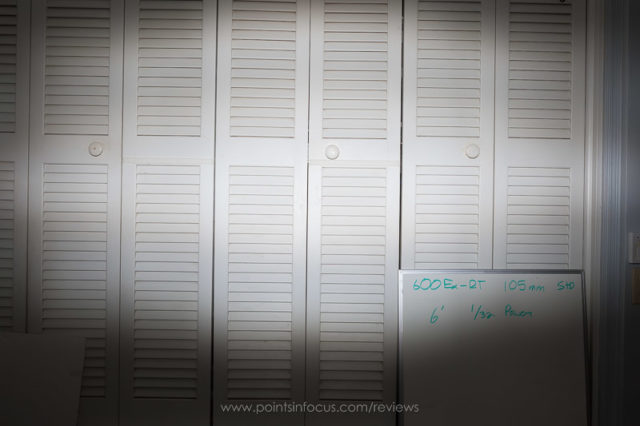

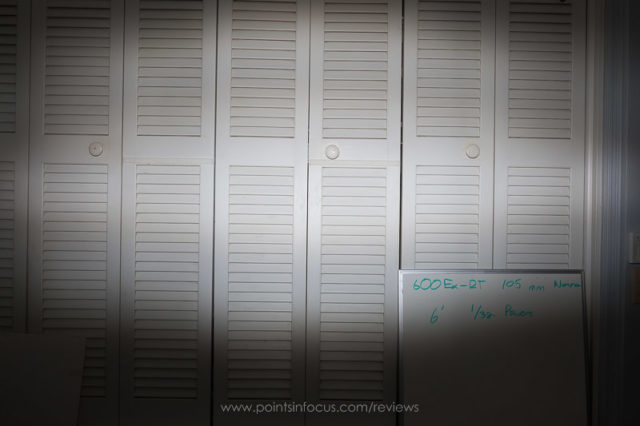
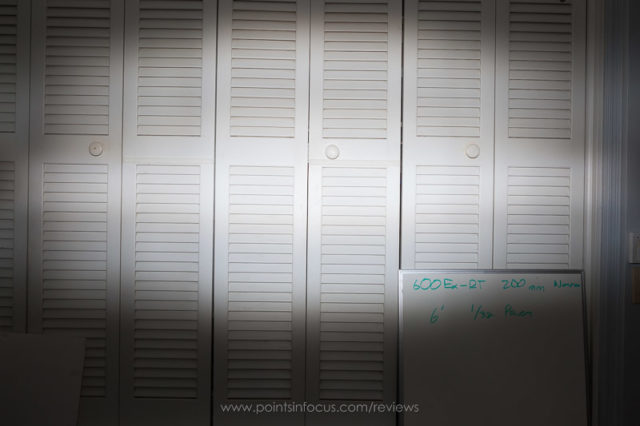


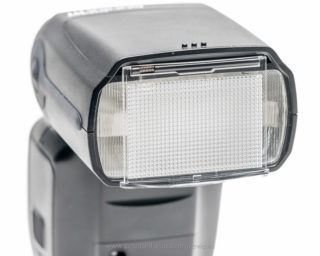

Comments